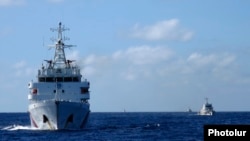China has removed an exploratory rig from disputed waters in the South China Sea, two months after its placement near the Paracel Islands sparked diplomatic tensions with Vietnam.
After finding signs of oil and gas off the coast of the archipelago claimed by both countries, the rig is being towed to the Chinese island of Hainan a month ahead of the announced end-date for drilling.
Wang Zhen, of the China National Petroleum Corporation, said prospecting went as planned despite opposition from Hanoi.
"During the operation, as we've seen from the media reports, Vietnam held a series of protests and made disruptions. We oppose their actions from the angle of production. But we pushed forward our plan smoothly as scheduled and completed the task on time," said Wang.
Hanoi on Wednesday called the rig's placement "completely illegal" and demanded China not repeat the act.
Boundary disputes in one of the world's most heavily navigated waterways created solidarity in recent months between Japan, the Philippines, and Vietnam, which all challenge China's maritime claims.
China deployed the $1 billion state-operated oil rig in May, within what Vietnam considers its exclusive economic zone.
Early analysis from the state-owned oil company shows "basic conditions and potential for oil exploration," but Wang Zhen told Chinese state media further testing would depend on what a deeper analysis of data gathered during the last two months shows.
The rig's placement was seen as one of China's boldest yet to advance its wide-reaching maritime claims in the South China Sea, where it also has disputes with Malaysia, Brunei and Taiwan.
In a June letter to U.N. Secretary General Ban Ki-moon, China's Deputy U.N. Ambassador Wang Min said Vietnam was violating China's sovereignty and posing a "grave threat" to Chinese workers by disrupting drilling.
Hanoi has accused China of firing water cannons at, and ramming Vietnamese fishing boats, including one that sank. Beijing says Vietnam is the aggressor and that its ships are ramming Chinese vessels.
Vietnam later said it sent its own letter to Ban, demanding Beijing immediately withdraw the oil rig and all other ships, which it said violate Hanoi's sovereignty.
The dispute also led to mass anti-China riots last month in Vietnam, where angry mobs destroyed Chinese-owned factories, killing at least four people, injuring dozens, and forcing the evacuation of thousands of Chinese workers.
Some information for this report was provided by AP, AFP and Reuters.












